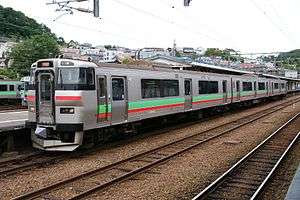731 series
The 731 series (731系) is an AC electric multiple unit (EMU) train type operated by Hokkaido Railway Company (JR Hokkaido) on Sapporo area suburban services in Hokkaido, Japan since 1996.[1]
| 731 series | |
|---|---|
 731 series set G116 in August 2009 | |
| Replaced | 711 series |
| Constructed | 1996–2006 |
| Entered service | 1996 |
| Number built | 63 vehicles (21 sets) |
| Number in service | 63 vehicles (21 sets) |
| Formation | 3 cars per trainset |
| Fleet numbers | G-101–121 |
| Operator(s) | JR Hokkaido |
| Depot(s) | Sapporo |
| Line(s) served | Hakodate Main Line, Chitose Line |
| Specifications | |
| Car body construction | Stainless steel |
| Car length | 21,670 mm (71 ft 1 in) (end cars), 21,300 mm (69 ft 11 in) (intermediate cars) |
| Width | 2,800 mm (9 ft 2 in) |
| Height | 3,620 mm (11 ft 11 in) |
| Doors | 3 per side |
| Maximum speed | 130 km/h (80 mph) |
| Electric system(s) | 20 kV AC (50 Hz) |
| Current collection method | Overhead line |
| Multiple working | 721 series, 733 series, 735 series, KiHa 201 series |
| Track gauge | 1,067 mm (3 ft 6 in) |
Formation
As of 1 October 2016, 21 three-car sets are in service, numbered G-101 to G121, and based at Sapporo Depot. The trainsets are formed as follows, with one motored intermediate car and two non-powered driving trailer cars.[2]
| Car No. | 1 | 2 | 3 |
|---|---|---|---|
| Designation | Tc' | M | Tc |
| Numbering | KuHa 731-100 | MoHa 731-100 | KuHa 731-200 |
| Capacity (total/seated) |
141/50 | 151/52 | 143/50 |
Car 2 is fitted with one N-PS785 single-arm pantograph.[2]
Interior
Seating consists of longitudinal bench seating throughout, without the vestibule areas used on the earlier 721 series trains.[1]
- Interior view in February 2010
History
A total of 63 vehicles (21 sets) were delivered to Sapporo Depot between 1996 and 2006. The first units entered service from 24 December 1996.[3]
From the start of 22 March 1997 timetable revision, 731 series EMUs were operated in multiple with KiHa 201 series DMU sets over certain routes.[3]
Polycarbonate window protectors were added in 2002, and the original pantographs were replaced with single-arm pantographs between 2004 and 2005.[3]
Fleet history
The individual build histories of the fleet are as follows.[2]
| Set No. | Delivery date |
|---|---|
| G-101 | 12 December 1996 |
| G-102 | 10 December 1996 |
| G-103 | 13 December 1996 |
| G-104 | 14 December 1996 |
| G-105 | 23 February 1998 |
| G-106 | 24 February 1998 |
| G-107 | 24 February 1998 |
| G-108 | 22 March 1998 |
| G-109 | 23 March 1998 |
| G-110 | 24 March 1998 |
| G-111 | 16 December 1998 |
| G-112 | 17 December 1998 |
| G-113 | 18 December 1998 |
| G-114 | 19 December 1998 |
| G-115 | 20 December 1998 |
| G-116 | 20 December 1998 |
| G-117 | 21 December 1998 |
| G-118 | 13 December 1998 |
| G-119 | 13 December 1998 |
| G-120 | 6 March 2006 |
| G-121 | 5 March 2006 |
References
| Wikimedia Commons has media related to 731 series. |
- Jēāru zensharyō handobukku: Rail Magazine 2009 JR全車輌ハンドブック2009 [JR Rolling Stock Handbook 2009]. Japan: Neko Publishing. 2009. ISBN 978-4-7770-0836-0.
- Jr電車編成表 JR電車編成表 2017冬 [JR EMU Formations - Winter 2017] (in Japanese). Japan: Kotsu Shimbunsha. 16 November 2016. p. 7. ISBN 978-4-330-73716-4.
- JR電車編成表 2010夏 [JR EMU Formations - Summer 2010]. Japan: JRR. May 2010. p. 2. ISBN 978-4-330-14310-1.